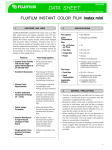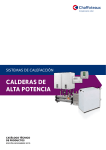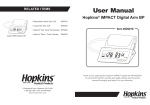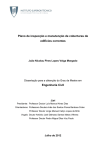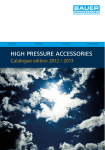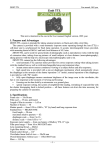Download Fujifilm FP-100C Silk
Transcript
AF3-129E INSTANT PHOTO SYSTEMS FUJI INSTANT COLOR FILM New FP-100C / FP-100C SILK 1. FEATURES AND USES 2. SPECIFICATIONS The New FUJI INSTANT COLOR FILM FP-100C/FP100C SILK is a peel-apart-type instant color film with an ISO speed rating of 100. As a daylight film, it is optimized for shooting under sunlight or electronic flash. Its ability to produce photos of superb quality makes this film ideal for a wide range of commercial uses, including product photography requiring long exposures, microphotography, CRT image recording, and of course identification and portrait photography. This film, in regular size, can be used in cameras and other photographic equipment that accept instant film with a photo size of 85×108 mm, and those provided or fitted with an instant camera back. Film Speed Color Temperature Photo Surface Finish Coating Number of Prints Size • Improved Light-fading Characteristics • Further Extended Low-temperature End (from 15°C to 10°C) 10.2 ×13.1 cm (4×5 in.) [4×5 size] Image Area Approx. 73×95 mm Approx. 89×118 mm Photo Size Approx. 85×108 mm Approx. 102×131 mm FUJI INSTANT CAMERA Applicable camera and FP-14/FP-14II/FP-14 DUAL other Cameras and other photographic photographic equipequipment ment that accept instant film with a photo size of 85×108 mm, and those provided or fitted with an instant camera back (e.g. Fuji Instant Back PA-1) and Fuji Instant Holder PA-145. Minimized decrease in sensitivity, color balance variations, and reduced gradation imbalance when used in low illumination or long exposure situations • Decreased light-fading rate of about one-fourth that of the current film, allowing long-term storage under direct sunlight Cameras and other photographic equipment that accept instant film with a photo size of 4×5 in. (102×131 mm), and those fitted with an instant film holder (e.g. Fuji Instant Holder PA-45). 3. PRECAUTIONS DURING USE Camera Loading Precautions • Before loading the camera, check the development roller and clean it if dirty. • Hold the film pack by the edges, as indicated. Do not apply any pressure to the black covering paper or the "Do not press here" mark on the back. • Wider range of applications in low-temperature environments, including ID photo shooting during the winter and outdoor commercial photography under severe conditions • Reduced color variations • Reduced Color even in cases of short/long Variations Caused peeling time, decreasing by Differences in the number of unacceptthe Peeling Time able print results caused by mistakes in the peeling time • Reduced Color Cast after Peeling 8.5×10.8 cm (3 1/4×4 1/4 in.) [Regular size] Film Pack Size Approx. 88×134×18 mm Approx. 110×157×18 mm Features • • Enhanced Reciprocity Characteristics When Shooting under Low Illumination and with Long Exposure Times • ISO 100/21° • 5500 K (daylight-type) • Glossy and silk • Unnecessary • 10 per pack • Always load the camera in subdued light avoiding direct sunlight. • Hold the film pack with the film side parallel to and facing the exposure plane and then lower the non-tab end first into the camera back followed by the tab end. • Reduced magenta cast after peeling, making it possible to obtain accurate print results faster –1– FUJIFILM PRODUCT INFORMATION BULLETIN • FUJI INSTANT COLOR FILM New FP-100C / FP-100C SILK • After loading, make sure that the white tab is not folded between the film pack and camera back, then close and lock the rear cover. • Pull out the black covering paper bringing with it the first white tab, and the camera is ready to use. • For further exposure and handling precautions, refer to the instructions supplied with the particular camera. rear cover in subdued light and pull the film out by the black tab. (The film that is removed in this manner cannot be used again, but the remainder can be used.) If the development roller and film exit are found to be dirty, clean them before closing the rear cover. 4. FILM HANDLING PRECAUTIONS Development Times and Temperatures • This film is designed for use at temperatures between 10°C and 30°C (50°F and 95°F), but yields best results at 25°C (77°F). • The table below provides the development times for this film according to encountered temperatures. For best results, be sure to observe the following development times and temperatures after pulling out the film sheet. Do not attempt to separate the negative and positive sheets before the temperature specified times indicated below have elapsed. CAUTION • Each film sheet contains a caustic (highly alkaline) processing fluid. Never cut, tear or punch holes in unused films. Avoid skin contact with this processing fluid. • Peeled-apart negative sheets should be folded inward upon themselves when discarded. When discarding negative sheets and other waste materials, be sure to avoid contact with children, pet animals, paper, clothes, furniture and other important objects or materials. • Should you get some of this processing fluid on your skin, flush it off immediately with lots of water. If any of the fluid gets into your mouth or eyes, flush the affected area immediately with lots of water, then see your doctor. Temperature°C (°F) 35 (95) 30 (86) 25 (77) 20 (68) 15 (59) 10 (50) Development Time (sec.) 60 75 90 120 180 270 • If development times are shorter or longer than specified, undesired photos may result. Development Procedures • Hold the white tab and pull it straight out bringing the black tab through the film exit. • Hold the center portion of the black tab, and pull it out at an even speed. Be sure to pull the black tab in a direction within the film plane. If pulled in a slanting direction, the white tab may break inside the film pack. When pulling, do not bend, fold or press the film and do not stop pulling before it is entirely removed from the camera, or undesired results, such as processing fluid leakage, incomplete processing fluid spread or image unevenness may occur. • When film has been removed from the camera, start development time measurement immediately. Do not rub, fold or separate developing films or undesired spots may appear on finished photos. • After the specified development time has lapsed, separate the negative and positive sheets at a fixed but rapid speed, starting with the black tab end. • The photo will be moist immediately upon separation. Moist photos should not be placed on other photos or paper lest they stick. When immediate use is essential, dry photos using a dryer. • If the white tab does not protrude from the camera, open the camera rear cover in subdued light, pass the white tab through the white tab exit and close rear cover. The remaining films can be used as they are if correctly set. • If the black tab does not come out when the white tab has been completely pulled out, open the camera • Photographic properties may change with time. Be sure to use the film before the expiration date on the package. • Avoid opening a film pack or loading a camera under direct sunlight. After opening the film, do not leave it in a bright place. Load it into the camera as quickly as possible. • When handling a film pack, do not put pressure on the light-shielding cover sheet or within the slots on the rear of the pack. This may cause a film-ejection failure or unevenness in the photo. • Unprocessed film should be kept away from X-rays used to inspect checked-in baggage, etc. at airport terminals. Strong X-rays can cause fogging of unprocessed film. It is recommended such film be placed in your carry-on baggage whenever possible. (Consult with airport personnel for details.) • Film fogging may occur in hospitals, factories, laboratories and other locations using X-rays. Keep films away from radiation sources. –2– FUJI INSTANT COLOR FILM New FP-100C / FP-100C SILK • FUJIFILM PRODUCT INFORMATION BULLETIN 5. FILM STORAGE 7. RECIPROCITY CHARACTERISTICS • The photographic and physical properties of film are adversely affected by high temperature and humidity, as well as by formalin vapor and other harmful gases. To minimize these adverse effects, film should be stored in a dry, well-ventilated place. • For long-term storage, keep film in a refrigerator [at a temperature below 10°C (50°F)]. Place opened film packs into polyethylene or vinyl bags before refrigerating them. • After removing film from a refrigerator, you should wait (at least 12 hours) for it to reach room temperature before opening it. If you open the film while it is still cold, it may be adversely affected by condensation. • After loading film into a camera, you should expose it as soon as possible. • Cameras loaded with film should be stored with as little exposure as possible to harmful gases, high temperatures, and high humidity. New building materials (such as coated plywood) and newlymanufactured furniture, paints and bonding agents are a possible source of formalin vapor. Do not store loaded cameras or film within their vicinity. This film exhibits little gradation imbalance at low illumination levels and during long exposures. With color balance correction, this film produces good photographic results. Use the following correction values as a general guide. Exposure Time (sec.) Exposure Correction Color Balance Correction 1/1000 1/100 1/15 1/4 1 4 8 16 — — — + 1/2 stop + 2/3 stop + 1 stop + 1 1/2 stops + 2 stops — — — — 5R 5Y+7.5R 5Y+7.5R 7.5Y+12.5R 8. NEW TECHNOLOGIES INCORPORATED IN New FP-100C/FP100C SILK 8-1 New Direct Positive Sigma Crystal Technology • Enhanced Reciprocity Characteristics Direct Positive Sigma Crystal Technology minimizes the decrease in sensitivity, color balance variations, and the gradation imbalance that occur in the current film during shooting under low illumination and long exposures. This film produces superb print results with little gradation imbalance in the highlights to the shadows from long exposures of 1 to 10 seconds under low-light conditions. • Further Extended Low-temperature End (from 15°C to 10°C) Development-accelerating technology (new development accelerator, new nucleation accelerator, new color dye-releasing accelerator) first used in INSTAX films has been adapted for use in peel-apart film, extending the low-temperature end and enabling shooting over a wider range of temperatures. The minimum temperature extends from 15°C (59°F) to 10°C (50°F). 6. PHOTO STORAGE • The quality of finished photos will change during storage if exposed to strong light, high temperatures, and high humidity. Photos are also affected by exposure to certain gases. For optimum preservation during long-term storage, keep photos in a dark, dry and well-ventilated location away from harmful gases. • As with all sensitive materials, images produced on this film are subject to discoloration or fading with time. The Fuji Photo Film Co. disclaims any responsibility for any discoloration or fading that may occur with this film. • Certain adhesives may cause color dyes to discolor or fade when used to mount photos. Liquid glues may permeate the mounting sheet, causing mounting sheets to adhere to each other when stacked. It is recommended that glue sticks be used instead. When using liquid glues, it is recommended that only a light coating of glue be applied and that the glue be confirmed dry before storage. • When keeping photos on file, avoid direct image-toimage contact, especially with photos that are still moist. Such contact may cause irreparable damage. When storing photos, completely dry them and exercise care so that they are not placed one on top of the other or front to front. 8-2 New Image Stability Technology · Clear Protective Layer · New Dye-fixing Technology · New Developer Stabilizer • Improved Light-fading Characteristics A clear protective layer has been newly introduced to cut ultraviolet light, while a new color dye stabilizer enhances color dye durability. This results in improved light-fading characteristics and a decrease in the color fading rate to about one-fourth that of the current film. • Reduced Color Cast after Peeling The use of a new processing fluid-stabilizing technology suppresses oxidation of the processing fluid after peeling. This new technology has reduced the –3– FUJIFILM PRODUCT INFORMATION BULLETIN • FUJI INSTANT COLOR FILM New FP-100C / FP-100C SILK degree of M cast after peeling and also has speeded up its disappearance, making it possible to check print results easily. This peel-apart film has been provided with development-accelerating technology first introduced in INSTAX films for enhanced balance between the different development rates of each color. Compared to the MR cast that appears when the peeling time is too short, and the G cast that appears when the peeling time is too long, which are pronounced in the current film, this technology has almost eliminated such color variations caused by mistakes in the peeling time. 8-3 New Development Process Accelerating Technology · Acceleration of Silver Development · Acceleration of Dye-release Reaction • Further Extended Temperature Range • Reduced Color Variations Caused by Differences in the Peeling Time 9. PACKAGING Item Production Number Contents 8.5×10.8 cm (3 1/4×4 1/4 in.) [Regular size] 8.5×10.8 cm (3 1/4×4 1/4 in.) [Regular size] SILK 10.2×13.1 cm (4×5 in.) [4×5 size] — 901-999 901-999 901-999 Film box The basic design is a Fuji green background, and the product name is printed in red for emphasis. The word "Professional" has been added. Envelope The printing color is the same as that of the current product. The product name, opening instructions, and processing time are printed on the front of the envelope. Film pack An all-plastic pack is used for the regular and 4×5 film sizes. Film (Photosensitive material sheet, Image receiving sheet, White tab, Black tab) The basic design is the same as that of the current film. The product name and production number are indicated on the bottom of the image receiving sheet and the development time, peel-apart method, and disposal method are indicated on the black tab. –4– FUJI INSTANT COLOR FILM New FP-100C / FP-100C SILK • FUJIFILM PRODUCT INFORMATION BULLETIN 11. CHARACTERISTIC CURVES 10. SPECTRAL SENSITIVITY CURVES 12. SPECTRAL DYE DENSITY CURVES –5– FUJIFILM PRODUCT INFORMATION BULLETIN • FUJI INSTANT COLOR FILM New FP-100C / FP-100C SILK 13. RESOLVING POWER 15 lines/mm 14. SCHEMATIC CROSS SECTION Black White Red Green Blue Expose Unexposed Silver Halide Exposed Silver Halide After Development Backing Layer Base Cyan Dye Layer Interlayer Red-sensitive Emulsion Layer Interlayer Magenta Dye Layer Green Sensitive Emulsion Layer Interlayer Yellow Dye Layer Blue-sensitive Emulsion Layer UV-Absorbing Layer Protective Layer Processing Liquid Peel Layer UV-Absorbing Layer Image Receiving Layer Neutralization Timing Layer Neutralizing Layer Resin Coated Paper Backing Layer Image Receiving Sheet Sensitized Material Sheet During Exposure Positive Separated from Negative Exposed but Underveloped Silver Halide Developed Metalic Silver Silver Halide neither Exposed nor Developed Transferred dye View Photo Black White Red Green Blue NOTICE The data herein published were derived from materials taken from general production runs. However, as Fujifilm is constantly upgrading the quality of its products, changes in specifications may occur without prior notice. –6– FUJI PHOTO FILM CO., LTD. 26-30, Nishiazabu 2-chome, Minato-ku, Tokyo 106-8620, Japan Ref. No. AF3-129E (EIGI-03.1-HB•3-2!) Printed in Japan






